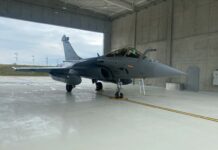MALE and HALE drones are unique assets providing long-term observation and strike capabilities. These attributes make them force multipliers.
The designations medium-altitude, long endurance (MALE) and high-altitude, long endurance (HALE) are largely self-explanatory, and summarise these unmanned aerial vehicles’ (UAVs) primary characteristics. Their flight altitude provides a significantly greater detection range and geographic coverage than that achieved by lower-altitude drones or aircraft. The long-endurance factor offers the potential for persistent presence in permissive airspace (especially when several aircraft are deployed to the operating zone), facilitating near real-time situational awareness and supporting commanders’ decision-making.
![An MQ-9B SkyGuardian flying above the UK during the RAF100 event. The UAV is known as the Protector RG Mk 1 in UK service. [GA-ASI]](https://euro-sd.com/wp-content/uploads/2025/06/SkyGuardian_GA-ASI-2-1024x682.jpg)
MALE
Individual MALE UAVs have different performance and mission profiles. By and large they tend to be flexible, with many aircraft being multitaskers. MALE category drones tend to have operational ceilings in the 7,000–15,000 m altitude range, although there is some leeway here. Their operational flexibility is a key reason why the MALE UAV segment has attracted such high interest in terms of both development and procurement.
The MQ-9 family
The MQ-9 aircraft family is produced by General Atomics Aeronautical Systems Inc (GA-ASI). It is generally classified as a MALE, although the maximum service ceiling of 15,000+ m places these UAVs squarely at the threshold to HALE territory. While they can be programmed for fully autonomous flight operations, these UAVs are classified as remotely piloted aircraft (RPA). The standard operating procedure is for a pilot and sensor/weapon system operator to be at the ground control station (GCS) at all times. The UAV’s embedded satellite link permits ground crews to operate the drones from across the globe.
The MQ-9 family has come a long way since the introduction of the MQ-9A Block 1 Reaper in 2007. General Atomics now produces several variants, including the MQ-9A Block 5 Reaper, the Reaper Extended Range (ER), the MQ-9B Guardian, and the MQ-9B Short Take-Off and Landing (STOL). Each variant is optimised for a different mission portfolio, which is reflected in moderate structural, payload and performance differences. Overall, the MQ-9 drones are often considered among the most capable MALE UAVs currently in service. This reflects unique combination of flight capabilities, sensor configuration and weapons payload.
The baseline MQ-9A Block 5 is highly suited for the hunter-killer mission, capable of locating and identifying time-critical, high-value targets and immediately attacking them before they relocate. Beyond this well-publicised mission, the task portfolio defined by the USAF includes general intelligence, surveillance, reconnaissance and targeting (ISTAR), close air support (CAS), combat search and rescue (CSAR), precision strike, convoy and raid overwatch, route clearance, and terminal air guidance. The MQ-9A has a wingspan of 20 m, a service ceiling of 15,240 m, and a 27 hour mission endurance (in its ER configuration the MQ-9A carries underwing fuel pods, adding a further seven hours of mission endurance). The internal and external payload capacity is 386 kg and 1,361 kg respectively. The baseline sensor package includes the Lynx Multi-mode synthetic aperture radar (SAR) and the multi-spectral targeting system (MTS), which integrates an infrared sensor, colour and monochrome day TV camera, and a shortwave infrared (SWIR) camera. The MTS also includes a laser illuminator and laser designator, the latter for guiding semi-active laser (SAL) guided munitions. Seven hardpoints accommodate a large weapons load out. The payload can include a mix of missiles and bombs including up to eight AGM-114 Hellfire missiles, laser guided GBU-12 and GBU-49 Paveway/Enhanced Paveway II bombs, GBU-38 and GBU-54 JDAMs, as well as the AIM-9 Sidewinder and AIM-92 Stinger families of munitions. The UAV has also been successfully tested with the Brimstone precision-guided missile and the GBU-39 SDB.
![A CG render of the MQ-9B in the SeaGuardian configuration. [GA-ASI]](https://euro-sd.com/wp-content/uploads/2025/06/SeaGuardian-above-Dubai_GA-ASI-Kopie-1024x682.jpg)
The MQ-9B is available in two variants, the SkyGuardian and the SeaGuardian. The latter is equipped with a mission kit geared toward maritime surveillance missions including anti-submarine warfare (ASW), anti-surface warfare (ASuW), and mine countermeasure missions (MCM). The MQ-9B can be equipped with the STOL wing and tail kit to permit operations from shorter expeditionary runways or from large flat-deck vessels such as aircraft carriers or helicopter carriers. The UAV’s enhanced capabilities permit pervasive presence over the most inaccessible and inhospitable terrains and waters including the increasingly important Arctic region.
To demonstrate the family’s capacity to operate above the Arctic Circle, on 10 September 2021, GA-ASI flew a company-owned MQ-9A through Canadian airspace past the 78th parallel, where it loitered at 78.31° North, using Inmarsat’s L-band Airborne intelligence, surveillance, and reconnaissance Service (LAISR). The planned activation of a new generation of satellite constellations by 2026 is expected to assure the MQ-9B polar access around the world.
MQ-1C Gray Eagle
Sporting a 17 m wingspan and a 1,633 kg MTOW, the MQ-1C Gray Eagle is sometimes described as the smaller brother of the MQ-9. Also produced by GA-ASI, it is geared toward the needs of the ground forces, in particular the US Army. It operates in support of Army field commanders and conducts wide-area intelligence, surveillance, and reconnaissance (ISR), convoy protection, improvised explosive device (IED) detection and defeat, CAS, communications relay, and weapons delivery missions.
The MALE UAV can carry four Hellfire missiles in addition to optronic sensors, SAR, a ground moving target indicator (GMTI), and a communications relay. Internal and external payload capacity are limited to 261 and 227 kg respectively. The Gray Eagle achieves significant loiter capability with a 25 hour mission endurance, flying at altitudes up to 8,800 m. Alternatively, it can operate in direct manned-unmanned teaming (MUM-T) mode together with AH-64 Apache attack helicopters, identifying targets for the helicopter’s weapons or augmenting the Apache’s arsenal with its own Hellfire missiles. It can be controlled through either a GA-ASI GCS or the US Army One System Ground Station. Like the Reaper/Guardian, the Gray Eagle is equipped with a single rear-mounted pusher propellor. Yet unlike the MQ-9, which requires jet fuel for its turboprop engine, the MQ-1C’s heavy fuel engine (HFE) consumes either jet fuel or diesel, potentially easing the logistical burden in the field.
![A Gray Eagle 25M in flight. [GA-ASI]](https://euro-sd.com/wp-content/uploads/2025/06/Gray-Eagle-25M-Kopie-1024x576.jpg)
Eurodrone
The Eurodrone consortium, (comprising Airbus as lead, Dassault Aviation, and Leonardo) is developing a large MALE drone with a 30 m wingspan, an MTOW in the 13 tonne class, and a 2.3 tonne payload capacity. Two aft-mounted, Avio Aero Catalyst turboprop engines will provide up to 500 km/h (270 kn) of true airspeed. At the ILA 2018 air show, these were originally shown in a pusher prop configuration, but by ILA 2024, this had changed to a pull prop configuration. The objective operating ceiling is 12,200 m with up to 40 hours flight endurance, depending on mission and configuration. The mission profile includes ISTAR and ground attack over land, as well as a broad spectrum of maritime missions including ASW, AsuW and wide area surveillance. Airborne early warning (AEW) and command, control & communications are also part of the mission portfolio. The UAV will operate in all weather and environmental conditions, including severe cold and hot conditions.
Avionics and flight capabilities include automatic take-off and landing (ATOL), a traffic collision avoidance system (TCAS II), air traffic management communications, a DAA system, weather radar, a narrow/wide band redundant datalink. These elements satisfy the requirements for certification against NATO STANAG 4671 Ed. 3, as well as civil aircraft regulations such as EASA CS-25. As a result, the Eurodrone is intended to be able to operate without restrictions in non-segregated airspace.
![CG render of the Eurodrone in flight, armed with a notional air-to-ground munitions loadout. [Airbus]](https://euro-sd.com/wp-content/uploads/2025/06/Eurodrone-in-flight_Airbus-Kopie-1024x682.jpg)
The development programme began in 2016 as a joint project of France, Germany (as lead nation), Italy and Spain in coordination with the Organisation for Joint Armament Cooperation (OCCAR). Japan and India have been granted observer status, reflecting broader interest in the UAV. A combination of digital and physical design and prototyping is being employed. The project plans to maintain autonomy and avoid dependency on imports by sourcing components exclusively from within Europe. On 16 May 2024, Airbus announced that the Eurodrone had successfully passed its Preliminary Design Review. Less than a year later, on 11 April 2025, the company announced the opening of a Eurodrone laboratory in Manching, Germany; this facility will test all flight and ground systems before installation. A full system integration test will be performed before first flight, which is planned towards the end of the 2020s. Participating states so far plan to acquire a total of 60 aircraft and 40 ground control stations.
Bayraktar Akinci
Joining the Eurodrone in the twin-engine MALE UAV category is the Bayraktar Akinci, developed by Baykar Technologies. The Akinci is available in three configurations, each with distinct engine power and capabilities: the Akinci-A with two 450 hp Ivchenko-Progress AI-450S turboprop engines is considered the baseline model. The Akinci-B has two 750 hp Pratt & Whitney Canada PT6 turboprop engines, providing enhanced power and payload capacity compared to the A model. The Akinci-C is the most powerful variant in the family, with two 850 hp engines permitting higher altitudes and speeds, as well as greater payload capacity. The first flight test of the Bayraktar Akinci C took place on 24 February 2025. According to Baykar, the UAV is expected to operate in coordination with manned fighter aircraft.
![The Bayrakar Akinci with a notional munition loadout. [Baykar Technologies]](https://euro-sd.com/wp-content/uploads/2025/06/Bayraktar-Akinci-Kopie-1024x682.jpg)
In terms of mission systems, Baykar states that Akinci uses artificial intelligence (AI) to support signal processing, sensor fusion and situational awareness in real time. Onboard systems include an AESA radar with weather radar and SAR functionality, signals intelligence/electronic support systems, dual satellite communication systems, as well as an optronic day and IR sensor. In March 2025, Baykar announced that the Murad AESA radar had been successfully integrated onto the Akinci. The AESA, which is also being retrofitted onto the Turkish Air Force’s F-16 jets, will enable the drone to track and engage both aerial and ground targets, depending on munition loadout. The payload capacity is 1,500 kg, and includes a wide range of ordnance including small laser-guided bombs such as MAM-L and MAM-C, Mk81, Mk-82, and Mk-83 JDAM, glide bombs, as well as air-to-ground and air-to-air missiles (AAMs) including the domestically produced Bozdoğan and Gökdoğan AAMs.
HALE
HALE UAVs are flexible as well, although most such systems are not designed to carry ordnance. Several experimental or developmental HALE drones employ unconventional propulsion systems capable of extending flight endurance to weeks or even months. Operating altitudes can reach 18,000 m or higher – some HALE UAVs with extremely high altitude and endurance capabilities are even referred to as ‘high-altitude pseudo-satellites’ (HAPS) for their ability to provide coverage and persistence somewhat comparable to that achieved by low earth orbit (LEO) satellites.
RQ-4B/D and RQ-180
The RQ-4 Global Hawk strategic entered service with the USAF in 2001 with the mission of providing persistent near-real-time coverage using imagery intelligence (IMINT), signals intelligence (SIGINT) and moving target indicator (MTI) sensors. Since then, the RQ-4 has undergone several evolutions, with only the last variant, the Block 40, remaining is service as a global ISR asset. Equipped with both AESA and SAR, it is capable of simultaneously tracking moving ground targets and cruise missiles, as well as capturing imagery of stationary targets. The aircraft is controlled from a GCS crewed by a pilot and sensor operator. The updated GCS combines aircraft control, system and ISR sensor monitoring, data dissemination, automated sensor operations and mission planning.
![An RQ-4D of the NATO Alliance Ground Surveillance system. [Northrop Grumman]](https://euro-sd.com/wp-content/uploads/2025/06/RQ-4D-Northrop-Grumman-Kopie-1024x681.jpg)
What the Global Hawk lacks is stealth characteristics, making it unsuitable for contested airspace. The USAF plans to retire the remaining Block 40s by 2027 in favour of a more survivable system. In contrast, NATO has given no indication that it will prematurely retire the five RQ-4D units it has operated from Sigonella since 2021. Japan has also just introduced the RQ-4B, acquiring three units in 2022/2023. Additionally, the MQ-4C Triton variant which has been optimised for maritime operations is in service with the USN and the Royal Australian Air Force.
The USAF’s plans regarding the replacement for the Global Hawk are highly classified. Normally well-informed specialist publications have speculated for years about possibility of the RQ-180 filling this role. Few hard details on the RQ-180 are available, but it is purported to be a stealthy and survivable aircraft suitable for deep reconnaissance in high-threat environments and capable of integrated operations with manned aircraft. Range, endurance and altitude comparable to the RQ-4 would seem de rigueur in a replacement system.
![Screenshot of a future high-performance ISR drone captured from a USAF video. The voice-over referenced the ‘White Bat’ – a nickname for the RQ-180 – without identifying the image as that UAV. [USAF]](https://euro-sd.com/wp-content/uploads/2025/06/RQ180-USAF-Kopie-1024x576.jpg)
PHASA-35
The Persistent High Altitude Solar Aircraft (PHASA-35) is considered a HAPS. This is a lightweight solar-powered HALE UAV propelled by two electric motors and is aimed at providing persistent ISR. Development began in 2018 by the British firm Prismatic Ltd, which was acquired by BAE Systems in 2021.
The aircraft weighs a mere 150 kg, with a 35 m wingspan. Speaking at the July 2023 Royal International Air Tattoo (RIAT) at RAF Fairford, BAE’s business manager for UAV systems, Phil Varty, explained that the PHASA-35 uses a stronger and stiffer carbon fibre airframe than comparable systems, granting greater resilience in face of changing and adverse weather conditions while ascending and descending through the troposphere.
The aircraft’s two propellers are powered by electric motors. By day, electricity is generated by ultra-lightweight solar arrays embedded in the wings; excess energy is stored in long-life Lithium-ion batteries for overnight consumption. The power system has sufficient redundancy to ensure continued operation in case some panels or batteries fail over time. The independence from fossil fuels theoretically offers hope of extremely long mission endurance, potentially up to 12 months of uninterrupted flight.
With a flight speed of only 93 km/h (50 kn), the PHASA-35 is well-suited to prolonged uninterrupted surveillance of a specific area. It has been described as a cheaper and more flexible alternative to low-orbit satellites, or as a way to quickly augment or replace satellites in a crisis. Primary mission profiles are ISR, including wide area surveillance over land and sea, with secondary utility as a communications node. The aircraft has a 15 kg payload capacity. According to BAE, the payload is housed in a dedicated pod and operates independently from the aircraft’s main systems. This ensures that the payload can be quickly reconfigured without extensive modifications. The lightweight aircraft will not be armed.
![Preparing the PHASA-35 prototype for a flight test. [BAE Systems]](https://euro-sd.com/wp-content/uploads/2025/06/phasa-35-bae-Kopie-1024x575.jpg)
Additionally, BAE has developed a second demonstrator with more than twice the onboard solar power generation and storage capacity than the version tested in 2024. The firm expects these modifications to allow stratospheric test flights of increasing duration and complexity beginning in 2025. BAE expects the PHASA-35 to be ready for real-world operations in 2026.
Future developments
Based on current trends, future developments in MALE and HALE look to be largely aimed at enhancing endurance, survivability, and ISR or strike performance, while gaining or improving the ability to operate in more contested airspace. In the latter vein, UAVs will need to incorporate stealth technologies to reduce their radar signature, and implement jamming/spoofing resistance to negate enemy EW threats. AI will play an ever-increasing role, enhancing UAV autonomy and incorporating sensor fusion to boost real-time threat detection capability, situational awareness, and target acquisition. Finally, AI will advance MALE and, to a lesser extent, HALE aircraft’s ability to operationally integrate with manned and/or other unmanned aircraft. A symbiosis of the various platforms would likely increase both survivability and lethality across the force spectrum.
Sidney E. Dean


![SkyGuardian_(GA-ASI) 2 An MQ-9B SkyGuardian flying above the UK during the RAF100 event. The UAV is known as the Protector RG Mk 1 in UK service. [GA-ASI]](https://euro-sd.com/wp-content/uploads/2025/06/SkyGuardian_GA-ASI-2.jpg)











